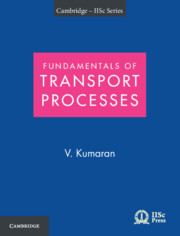Book contents
- Frontmatter
- Dedication
- Contents
- Preface
- 1 Introduction and Dimensional Analysis
- 2 Dimensionless Groups and Correlations
- 3 Diffusion and Dispersion
- 4 Unidirectional Transport: Cartesian Co-ordinates
- 5 Unidirectional Transport: Curvilinear Co-ordinates
- 6 Pressure-driven Flow
- 7 Conservation Equations
- 8 Diffusion Equation
- 9 Forced Convection
- 10 Natural Convection
- Bibliography
- Index
Preface
Published online by Cambridge University Press: 28 February 2025
- Frontmatter
- Dedication
- Contents
- Preface
- 1 Introduction and Dimensional Analysis
- 2 Dimensionless Groups and Correlations
- 3 Diffusion and Dispersion
- 4 Unidirectional Transport: Cartesian Co-ordinates
- 5 Unidirectional Transport: Curvilinear Co-ordinates
- 6 Pressure-driven Flow
- 7 Conservation Equations
- 8 Diffusion Equation
- 9 Forced Convection
- 10 Natural Convection
- Bibliography
- Index
Summary
An anecdote about Prof. P. K. Kelkar, founding director of IIT Kanpur and former director of IIT Bombay, was narrated to me by Prof. M. S. Ananth, my teacher and former director of IIT Madras. A distraught young assistant professor at IIT Kanpur approached the director and complained that ‘the syllabus for the course is too long, and I am will not be able to cover everything’. Prof. Kelkar replied, ‘You do not have to cover everything, you should try to uncover a few things.’ In this book, my objective is to uncover a few things regarding transport processes.
The classic books on transport processes, notably the standard text Transport Phenomena by Bird, Stewart and Lightfoot written about 60 years ago, provided a comprehensive overview of the subject organised into different subject areas. At that time, engineers were required to do design calculations and modeling for different unit operations, and for the sequencing of these operations in process design. This required expertise in laboratory and pilot scale experiments on unit operations and scaling up of these operations using correlations. Proficiency in developing, understanding and using design handbooks and correlations was also needed. In this context, the study of transport processes at the microscopic level, and its implications for design for unit operations, was a pioneering advance that has since become an essential part of the chemical engineering curriculum.
In the last half century, sophisticated computational tools have been developed for detailed flow modeling within unit operations, and for the selection and concatenation of unit operations for achieving the required material transformations. The ease of search for information and data today was inconceivable half a century ago. Routine calculations have been automated, and there is little need for routine tasks such as unit conversion, graphical construction and interpreting engineering tables. There is now a greater need for understanding physical phenomena and processes and their mathematical description.
Using a rigorous understanding of transport processes, an engineer usually contributes to process design in one of two ways. The first is the development and enhancement of models and computational tools for modeling of flows and transformations in unit operations; these result in higher resolution, better representation of the essential physics and inclusion of new phenomena.
- Type
- Chapter
- Information
- Fundamentals of Transport Processes with Applications , pp. xi - xivPublisher: Cambridge University PressPrint publication year: 2023

